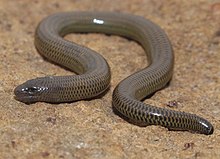
KNOWPIA
WELCOME TO KNOWPIA
Summary
Acontias breviceps, the shorthead lance skink or shortheaded legless skink, is a species of viviparous, legless, fossorial lizards occurring along the southern and eastern sections of the Great Escarpment in South Africa. It may grow up to 10 cm long.
| Shorthead lance skink | |
|---|---|

| |
| Scientific classification | |
| Domain: | Eukaryota |
| Kingdom: | Animalia |
| Phylum: | Chordata |
| Class: | Reptilia |
| Order: | Squamata |
| Family: | Scincidae |
| Genus: | Acontias |
| Species: | A. breviceps
|
| Binomial name | |
| Acontias breviceps Essex, 1925
| |

| |
| Synonyms[2] | |
| |
This skink was first collected in 1925 by Robert Essex at Hogsback in the Amatola Mountains in the Eastern Cape at an elevation of some 6000 ft. A disjunct second population exist in the Transvaal Drakensberg. Essex collected for the Albany Museum of Grahamstown, but a fire in 1941 destroyed most specimens and records.[3]
References edit
- ^ Conradie, W.; Bauer, A.M. (2018). "Acontias breviceps". IUCN Red List of Threatened Species. 2018: e.T128870065A115660145. doi:10.2305/IUCN.UK.2018-2.RLTS.T128870065A115660145.en. Retrieved 18 November 2021.
- ^ Acontias breviceps at the Reptarium.cz Reptile Database. Accessed 5 September 2020.
- ^ "A Biographical Dictionary of Contributors to the Natural History of the Free State and Lesotho" - Rodney Moffett
Bibliography edit
- Daniels, Savel R.; Neil J. L. Heideman, Martin G. J. Hendricks, Keith A. Crandall 2006. Taxonomic subdivisions within the fossorial skink subfamily Acontinae (Squamata: Scincidae) reconsidered: a multilocus perspective. Zoologica Scripta 35 (4): 353
- Essex, R. 1925. Descriptions of two new species of the genus Acontias and notes on some other lizards found in the Cape Province. Rec. Albany Mus. 3: 332–342.
- Greer, Allen E. 2001. Distribution of maximum snout-vent length among species of Scincid lizards. Journal of Herpetology 35 (3): 383-395
- Lamb, T.; Biswas, S. & Bauer, A.M. 2010. A phylogenetic reassessment of African fossorial skinks in the subfamily Acontinae (Squamata: Scincidae): evidence for parallelism and polyphyly. Zootaxa 2657: 33–46



